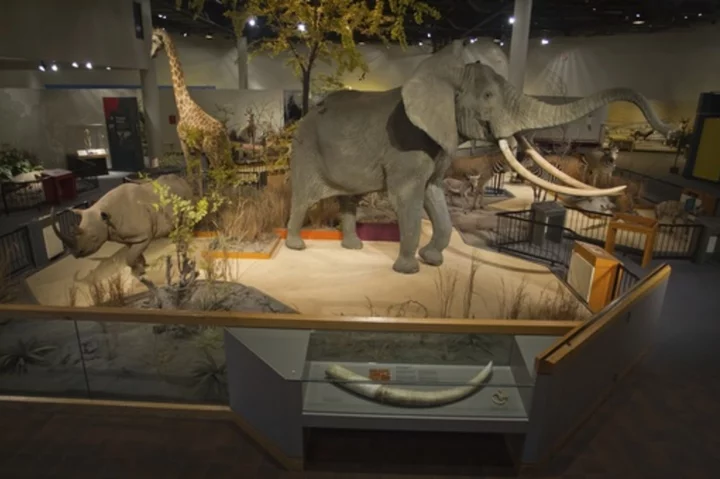The fate of the mounted lion, tiger, polar bear and gorilla that have long greeted visitors entering South Dakota’s largest zoo is grim after arsenic was found to be widespread in the taxidermy collection, creating a raging debate about whether the more than 150 animals should be destroyed.
Some locals who grew up around the menagerie, which used to fill a hardware store, are fighting the mayor and zoo officials to keep the collection, marshaling activism online and in the Sioux Falls City Council. They are buoyed by experts who say the arsenic risk is overblown, the mounts nothing short of art.
“They’re not stuffed animals. These were sculptures,” said John Janelli, a former president of the National Taxidermists Association, likening destroying them to scraping off the ceiling of the Sistine Chapel.
The arsenic, he adds, is a heavy metal, not something that wafts through the air.
“Just don’t lick the taxidermy," says Fran Ritchie, the chair of the conservation committee of the Society for the Preservation of Natural History Collections. “You'll be fine.”
Most institutions with older collections take safety protocols, like using special vacuums and wearing personal protective equipment while cleaning the taxidermy, said Gretchen Anderson, a conservator at the Carnegie Museum of Natural History in Pittsburgh.
But for Sioux Falls, there is “there is no acceptable level of risk when you are dealing with a known carcinogen,” City Attorney Dave Pfeifle told reporters last week.
The mayor and zoo officials believe reason and safety are on their side. But even if they can convince the town to get rid of the animals, they'll have to navigate a web of federal and state laws to do so.
The Endangered Species Act protects animals even in death, so the collection can’t be sold. Under federal law, they could be given to another museum. But state law stipulates that exhibits like this must remain within the state.
It wasn’t this messy 80 years ago when a Sioux Falls businessman embarked upon a series of international hunting expeditions chronicled in his eponymous book, “A True Safari Hunter: Henry Brockhouse."
“For walrus, you have to go out and travel the sea. If you see a head poppin’— one or two miles away — wherever it may be, you start shootin,’” one passage reads.
He proudly displayed some of his prize kills at his West Sioux Hardware store. But by the time he died in 1978, international laws and the Endangered Species Act were cracking down. There was a growing concern that hunters were pushing some exotic animals to the brink of extinction.
When the hardware store closed, Brockhouse's friend, C.J. Delbridge, snapped up the collection and donated it to the city. The natural history museum that bore Delbridge’s name opened in 1984. An African elephant that was mounted after Brockhouse’s death added to the display. China also donated a mounted giant panda.
In recent years the mounted animals showed their age, including some tears, said Great Plains Zoo CEO Becky Dewitz. As it considered what to do with them, her team had them tested.
In August, the results came back: 79% of specimens tested positive for detectable levels of arsenic, the city said. The report, obtained by The Associated Press, showed that the contaminated mounts included a jungle cat and monitor lizard.
With protective gear, taxidermy can be moved safely despite arsenic, said Jennifer Menken, the public collections manager at the Bell Museum of Natural History. Her institution moved 10 historic taxidermy dioramas to its new space at the University of Minnesota’s St. Paul campus about five years ago.
Other steps can be taken to keep the public safe, she said, including encasing taxidermy in glass. That protects them against temperature, humidity and, of course, visitors licking them.
But in Sioux Falls, cost was a barrier, said Dewitz. So now the animals are hidden behind barricades as the city considers its options.
Some items are earmarked for the National Wildlife Property Repository near Denver, which stores a massive collection of seized wildlife items, including elephant tusks and crocodile skin purses. But the U.S. Fish and Wildlife Service, which operates it, won't take any with arsenic, said spokeswoman Christina Meister.
Dewitz said she's had a hard time finding other takers, and Mayor Paul TenHaken said he fears the city could still face liability even if it gives them away.
“I know that’s a popular narrative to say that we would just take artifacts like this and treat it like a Papa John’s pizza box,” the mayor said, insisting that is not the case. He was critical of what he described as “misinformation.”
Critics claim that the city and the zoo found the arsenic on purpose, as part of a ploy to replace the space with a butterfly garden and aquarium.
Brockhouse’s granddaughter, Barbara Philips, suspects as much.
“I am sick to my stomach,” she said.
She wants the specimens to be repaired, and kept behind glass as her grandfather did. The 1981 donation agreement, which the AP obtained through a records request, said the mounts “shall be behind a partition of glass or other suitable material.”
The mayor is fed up with the whole thing, and has chastised City Council members who opposed the closure.
“There’s a million things I’d rather be working on right now than this,” the mayor said.
A Facebook group marshaling fans of the exhibit has more than 1,400 followers.
Group creator Jason Haack sells and displays a collection of “unique weird odd items” at his family-run Abby Normal’s Museum of the Strange south of Sioux Falls. He said three business area owners offered $170,000 to fight the closure. His attorney thinks it will be an uphill battle.
“What they’re doing could cause a ripple effect throughout the whole world of natural history museums, and people now questioning the safety of them,” Haack lamented.
The ultimate decision rests with the City Council, which is scheduled to hear a report and then vote at a pair of September meetings.









